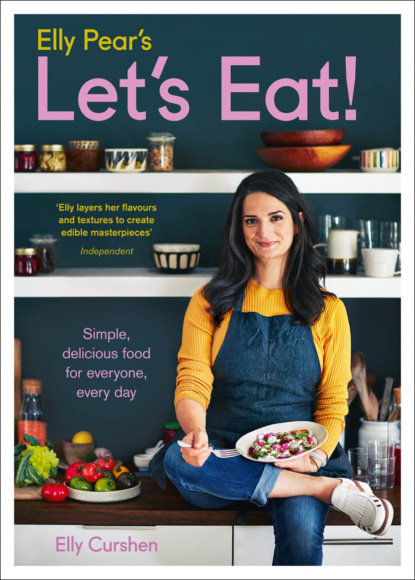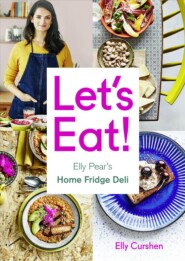По всем вопросам обращайтесь на: info@litportal.ru
(©) 2003-2024.
✖
Elly Pear’s Let’s Eat: Simple, Delicious Food for Everyone, Every Day
Автор
Год написания книги
2019
Настройки чтения
Размер шрифта
Высота строк
Поля
Pickled jalapeños, passata, pickled turnips, preserved lemons, roasted peppers, capers, olives, chermoula, anchovy fillets. They can live happily on the shelf until opened, then move to the fridge.
Asian ingredients
Miso, udon, thin rice and soba noodles, soy sauce (I use Kikkoman), Sriracha chilli sauce, rice paper wrappers, sesame oil.
Middle Eastern ingredients
Orange blossom water, tahini, sumac, dried rose petals, dried barberries.
Breadcrumbs
I always use fresh breadcrumbs, never the toasted shop-bought kind. Whenever I buy bread I slice it at home, freeze it and then blitz the crusts in a food processor and pop in a freezer bag. Whenever a recipe calls for breadcrumbs, use these.
Other random bits
Vegetable bouillon powder (stock), plain and self-raising flour, caster sugar, both dark and light soft brown sugars, tomato purée, freekeh, giant couscous, sultanas, marmalade, cornflour, dark chocolate, peanut butter, baking powder, porridge oats, instant polenta, cocoa powder, maple syrup, golden syrup, coconut flakes, desiccated coconut, panko breadcrumbs.
Fresh staples
Milk
I always buy organic. It is better in so many ways: for you, the cows, the farmers and the planet (look at organicmilk.co.uk (http://organicmilk.co.uk) for loads of interesting info), and it only costs a few pence more a pint than non-organic milk. I truly believe it also tastes so much more delicious.
Butter
Butter is something where it really pays to buy the best you can afford. It tastes so much better.
Yoghurt
I use thick Greek-style yoghurt most often and regular natural yoghurt sometimes too. Buy both organic wherever possible.
Eggs
My most used ingredient and I make sure I never run out. Always free-range, organic if you can. Happy chickens lay much nicer eggs. Remember that if you want to poach eggs, they need to be super, super fresh. As they age, the white breaks down inside the shell and you’ll find it very difficult to make a neat poached egg.
Bread
Long-life sliced bread makes me feel terrible. Proper, real bread (preferably sourdough) makes me feel happy. Simple as that. I buy a loaf, slice it up and stick it straight in the freezer. No bread ever gets wasted and I toast it straight from frozen. I have been known to buy bread while I’m away on a trip and carry it home in my handbag, slices emerging from my freezer for weeks to come, reminding me of my time away. What better holiday memento is there than one you can eat?
Salad leaves
Buy whole lettuces rather than bags of mixed leaves and wash them as soon as you get them home. Follow these instructions (as we do at The Pear Café) and your lettuce will last at least 4 days … Buying whole lettuces rather than prepped leaves will save you money, too. We use oakleaf and little gem lettuce at my café, but the same technique works for any lettuce. Fill your sink with ice-cold water. Cut the base off the lettuce, cut out the hardest section of core with the tip of your knife and separate the leaves. Plunge the leaves into the cold water and swish them around with your hand. Transfer to a large bowl, drain the sink and refill with Ice-cold water. Rinse the leaves a second time. Take a double handful of leaves and shake them as dry as you can over the sink. Move into a salad spinner and spin really well, pouring away the water every few seconds. The leaves must be totally dry before you continue. Lay a few sheets of kitchen paper inside the largest zip-lock bags you can find. Keeping the leaves whole (cut edges will turn brown quickly), fill the zip-lock bags up to the top, but don’t overfill them. Gently lay the bags flat In the bottom of your fridge (or the crisper drawer) and avoid putting anything on top. Change the kitchen paper every day if it looks wet.
Fresh vegetables and fruit
I’m incredibly lucky when it comes to shopping for food in my Bristol neighbourhood. I’m spoilt for choice and have a number of greengrocers within walking distance. I prefer shopping for veg at my local shops rather than in a supermarket for a number of reasons. Supporting local businesses is essential to me but the biggest draw is the selection of produce available. My favourite local grocer’s has a brilliant selection and everything is sold loose, so I can buy exactly what I need. Whether it’s a single chilli or a lone lemon – supermarkets tend to package things designed for families and that’s not how all of us live. If I buy just what I need, I avoid waste and unnecessary expense.
Tofu: lots of people are a bit scared of where to start. What do you look for on the packet? How do you prepare it? What – even – is it?
A beginner’s guide to tofu
I use tofu regularly. As I don’t eat meat, my protein sources come from elsewhere (mainly lots of pulses, dairy, eggs and tofu), and I’ve been using various kinds of tofu for years.
Tofu has been around in Asia for over a thousand years, but it’s still finding its way into Western kitchens and lots of people are a bit scared of where to start. What do you look for on the packet? How do you prepare it? What. Even. Is it?
The last question is simple to answer. Tofu is just like cheese but is made with soya beans rather than milk. Fresh soya milk is curdled, the curds and whey are separated, and the curds are then pressed into blocks. How firm the tofu is will depend on how much water is pressed out, The blocks are sometimes then smoked, which will make them firmer, as well as obviously giving them a smoky flavour!
Firm
(I like the Organic Smoked Tofu from Dragonfly, which is handmade in Devon.) This is the type you need for the nuggets (#litres_trial_promo). You’ll find it in the chiller cabinet in a cardboard box, inside which there’s a shrink-wrapped block of tofu with a bit of liquid. Cut open the pack and pour away the water. Sandwich the tofu between a few layers of kitchen roll or a clean tea towel and gently press down for about 20 seconds to get rid of the excess moisture. If you’re using it for a stir fry, it won’t crisp up until you’ve got it really dry, so change the paper a few times and press for longer. For the nuggets recipe, you don’t need to worry so much as the moisture is actually essential for puffing up the crispy shell.
Smoked and marinated
This sort of tofu is what I call ‘beginner’s tofu’ and you can’t go wrong. It also comes in a shrink-wrapped packet but is not at all wet. It can be eaten hot or cold, doesn’t need pressing and it has a stronger flavour than plain tofu (so more interesting for those who consider tofu a wobbly, bland blob). I’ve used this type with the lentil dahl (#ulink_3a6a8a1a-6b15-57c7-9828-bec2294eec9d). (I like the Taifun brand, the one with almonds and sesame seeds.)
(#ulink_681c576b-2a67-5305-bcf7-39b508a2b7df)
(#ulink_681c576b-2a67-5305-bcf7-39b508a2b7df)
This chapter contains 25 recipes – five different freezable base recipes, each with four different ways to serve them.
These ways to serve aren’t just ‘serving suggestions’ but proper, full recipes that incorporate the base recipe as a main element. The idea is that you can make big batches of the base but avoid eating the same thing over and over again. The bases are all ‘wet’ things that freeze well and then defrost and reheat quickly and easily. Some of the ways to use them are casual and perhaps best suited to a weeknight dinner or a speedy lunch when you’re just cooking for yourself. Others are smarter and would certainly be up to scratch if you have guests. They’re all simple, easy and nothing takes very long. You’ve invested the time in batch-cooking the base, so the ‘serving suggestions’ are designed to be quick and stress-free.
If you’ve got a big enough pot and enough freezer space, you can, of course, double or even triple these recipes. Just don’t forget to alter your cooking times accordingly.
So, equip yourself with plenty of plastic tubs and a permanent marker to label everything, stick the radio on, grab a drink and let’s cook!
Lentil, tomato and coconut dhal (#ulink_32e6a232-3cea-5e5c-a922-43bd9336686a)
As a soup with roasted peppers and toasted cashews (#ulink_014f96e4-a615-5fe1-b030-84c66d6f108c)
With a 6-minute egg and toasted breadcrumbs (#ulink_9538fd72-11af-508c-a24f-01b34cc96038)
With wilted greens, lemon and yoghurt (#ulink_7d6d08ba-6979-5923-983f-e3c5753e3769)
With seared tofu, avocado, pickles and seeds (#ulink_3a6a8a1a-6b15-57c7-9828-bec2294eec9d)
Lentil, tomato and coconut dhal (#ulink_60a88dae-7712-5b92-9351-01d54b63f782)
Learn how to make a dhal (a lentil-based curry) and you are opening up a whole world of nutritious, delicious, cheap meals. It is quick to make, so you can whip this up from scratch after work even if you’ve not had time to batch-cook in advance. All the warming spices make this ‘spiced’ (think fragrant and aromatic) not ‘spicy’ (think chilli heat). Add extra chilli flakes if you like it hot.
I’ve used whole tinned plum tomatoes in this one, to add a nice contrast in texture. You can use a ready-made garam masala spice blend or make your own. Either way, make sure your spices are fresh and not from an open packet, shoved in the back of your cupboard, six years out-of-date. Mentioning no names.
Makes 6 portions (approx. 460g each)
—
4 tbsp oil (vegetable, sunflower, olive or coconut) or ghee






